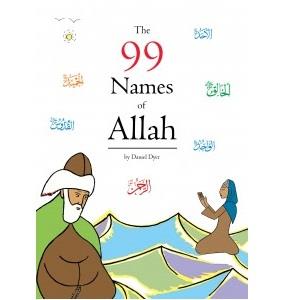
‘The 99 Names of Allah’ creatively introduces younger readers to names that describe God, complemented with sacred traditions, activities, and reflections.
I ask Daniel Dyer, the illustrator behind this colourful guide about what makes this book unique, how they have explored Islamic spirituality, and how we can help bring this book to life.
What inspired this book?
The beauty and power of the Names drew me. Something also told me that children need to explore them – not just adults. It began as a simple poem to orientate children to the Names, and then evolved into something much broader and, insha’Allah (God willing), much deeper.
What is unique about ‘The 99 Names of Allah’ book?
I don’t know of any children’s book in English that explores the 99 Names of Allah in way that I would wish for my children. For me, an exploration of the Names needs to be centred on the heart, on awakening children’s innate empathy, creativity and insight. It needs to help children to understand Allah’s attributes and to appreciate the places where these attributes are best reflected: in themselves and the natural world.
As well as helping to foster a spiritual and ecological awareness, it needs to help them appreciate the diversity of modern societies. It should help them identify with all humanity, not just Muslims, and perhaps help them to appreciate that there is more than one path to God. It also needs to be imaginative, colourful and richly illustrated in order to really engage.
What do you hope to achieve from this book?
With this book, and all our future books, we aim to help young readers develop a relationship with the Divine; promote a spiritual, creative and heart-based approach to education; foster a sense of unity and interdependence between people of different faiths and cultures; cultivate an awareness of the equality of women and men; and encourage reverence and respect for the natural world.
Will the book appeal to people of all ages and faiths?
We hope so, insha’allah. Writing the book is certainly an education for me, and if other adults can benefit from it as they share it with their children or students that would a great blessing. The book makes use of wisdom from other faiths, so people of all faiths may find their own faith used to complement the understanding of some Islamic concept, and Muslims themselves are given the opportunity to deepen their appreciation of other religions.
What ideas and techniques have you used in this book to explore Islamic spirituality?
We use a phonetic guide to help readers pronounce each Name, and, after a brief introduction to the essential meaning, a section suggests where readers might see signs of the Name in the outer world and within themselves. We also draw quotations directly from the Quran, great Prophets such as Muhammad, Jesus and Moses; and great personalities.
Our aim is to give women as strong a representation as possible and to promote an appreciation of other faiths whilst celebrating Islam.
The book is primarily aimed at 10-14 year olds, but it has been designed so that younger children can benefit from it too, especially if reading with a parent or teacher.
What research did you undertake, and how did you come up with the ideas, such as the reflection and activities sections?
We want to encourage creativity and the asking of questions. We believe that children have an innate knowledge within themselves and that the best way to learn is to be creative.
Rather than merely spoon-feeding them information or a list of does and don’ts, the reflections and activities section aims to help children intuit knowledge and moral values for themselves. We want them to gain an experience of their own inner life and the workings of their hearts. For instance, when learning about Ar-Rahman, it is more important to us that children actually build compassion for others, rather than just being able to say what compassion is.

Add new comment